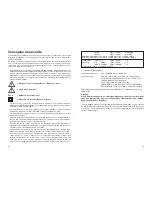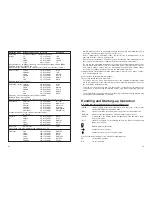
26
Carrying out Measurements
Warning!
Always observe the maximum permissible input values! Observe the
safety instructions!
Measuring voltages
Proceed as follows to measure DC voltages up to max. 1000VDC:
a) Connect the measuring lines to the measuring instrument turned off; ensure the
correct polarity. Connect the red measuring line to the Hz/V/ohm input and the
black measuring line to the „COM“ (= ground or „-“). Make sure they are plugged
properly.
b) Move the rotary switch to “V
” and turn on the measuring instrument. After a
short initialisation phase (all segments are visible), the „AUTO“ function switches
to the lowest possible range of measurement (mV).
c) Connect the measuring prods to the object to be measured.
Press the blue second-function button for measuring AC voltages (up to max.
750VACrms).
Notes!
- For the VC-840 True Rms, the true effective value of the alternating voltage is
measured (True Rms = real effective value). Moreover, the following subfunc-
tions can be set for both multimeters:
Holding the measuring value „HOLD H“, reference measurement „REL“ and
manual range selection „RANGE“.
- For open measuring lines it is possible that irrational values are indicated up
to 0.5V due to the high input sensitivity.
Measuring resistance values
Caution!
Make sure that all the circuit parts, switches and components as well as other
objects to be measured are disconnected from the voltage source at all times.
Proceed as follows to measure resistance values up to max. 40 MOhm:
a) Connect the measuring lines to the measuring instrument turned off; ensure the
correct polarity. The red measuring line is to be connected to the Hz/V/ohm input
and the black measuring line to the „COM“ (= ground or „-“). Make sure they are
plugged properly.
b) Move the rotary switch to „
Ω
/
/
/
“ and turn on the measuring instru-
ment. After a short initialisation phase (all segments are visible), the „AUTO“ func-
tion switches to the highest possible range of measurement (MOhm).
c) Connect the measuring prods to the absolutely voltage-free object to be measured.
Note(s)!
The following subfunctions can be set:
Holding the measuring value „HOLD H“, reference measurement „REL“ and
manual range selection „RANGE“.
V
31
- Switch off the measuring instrument.
- The interface is integrated at the rear side. Turn over the measuring instrument.
- Take the interface line and slide the coupler into the wedge-shaped recess
up to the stop.
- The connection has been established.
- The transmission is performed in an unidirectional manner (into one direction).
- Load the DEMO software (from Windows ‘95) by using the explorer (Setup
or Install) of your PC (from Pentium I) and follow the instructions displayed,
or do it via Autostart (CD inserted, at start of Windows).
Notes!
The main memory must have at least 8MB. The DEMO software additionally
requires a memory space of approximately 8MB on the hard disc. Moreover, a
free serial interface is necessary. The transmission rate is 2400 bauds.
Maintenance, Replacing the Battery,
Replacing the Fuses, Setting up the Mea-
suring Instrument
a General
To ensure the accuracy of the multimeters VC-820 and VC-840 over a longer period
of time, they should be calibrated once a year, possibly in our calibration laboratory.
To clean the devices or the display window and measurement lines, use a clean, lint-
free anti-static and dry cleaning cloth.
Caution!
Do not use detergent that contains carbon, petrol, alcohol or similar sub-
stances for cleaning purposes. Otherwise, the surface of the measuring instru-
ments will be corroded.
b Replacing the battery
A 9V compound battery is required to operate the individual measuring instrument. If
the replace battery symbol is displayed approximately 8 hours before the battery
goes dead, it will be necessary to replace the battery. To do this, proceed as follows:
- Switch off the measuring instrument by separating it from the measuring
circuit and disconnect the measuring lines.
- Unscrew the fastening screw of the battery compartment (centre screw at
the rear side of the measuring instrument) by using a suitable screwdriver
(crosshead). It is not necessary to open the device completely for replac-
ing the battery.
- Remove the battery compartment by drawing it slightly. The (used) battery
is secured by a clamp. Use a suitable crosshead screwdriver to remove
this clamp.
- Take out the used battery and replace it by a new one of the same type.
Pay attention to the polarity!
- Fix the clamp till it locks into place and put the battery compartment again
onto the device.
- Now, close the cover carefully. During the replacement make sure that the
battery contact springs in the measuring instrument will not be deformed.

















